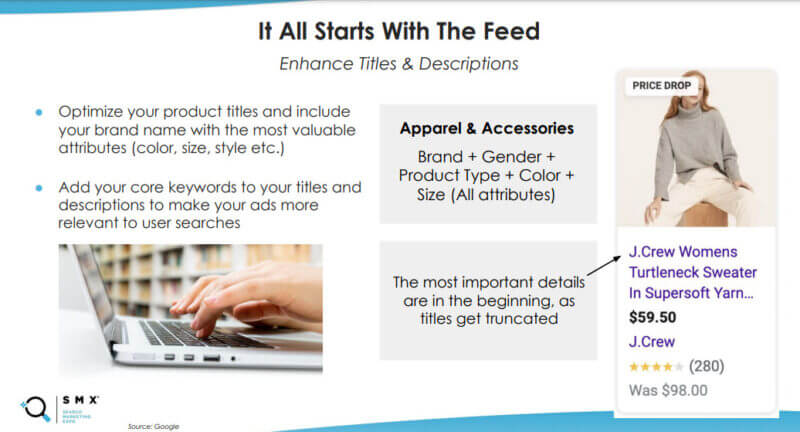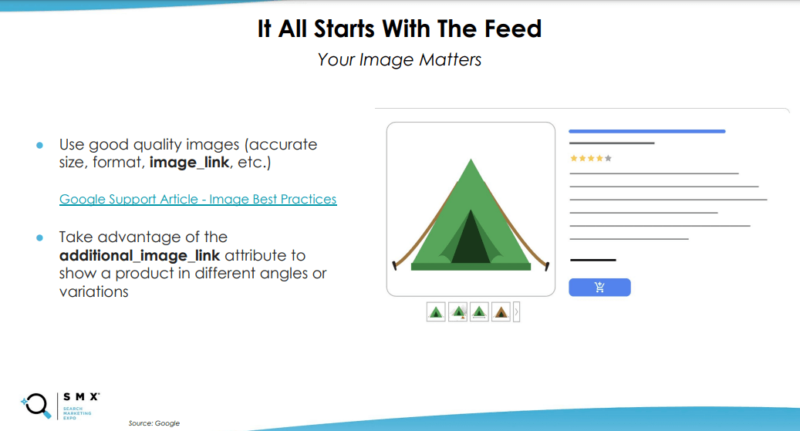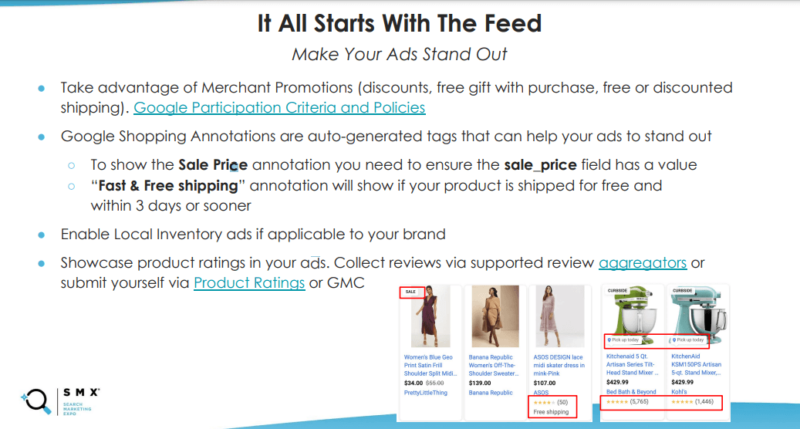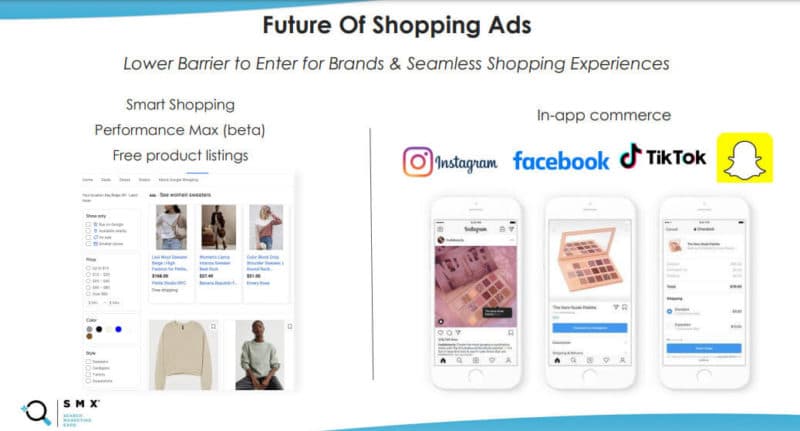How marketers can best optimize their Google Shopping ads

The digital commerce space is growing at a rapid pace and marketers across all industries are looking for the most effective ways to enhance their shopping campaigns. Many naturally turn to Google Shopping, one of the largest online shopping platforms available to searchers.
However, moving your shopping campaigns to Google isn’t enough to be successful; marketers need to ensure their shopping feeds are optimized for search.
“We can’t avoid this topic of feed optimizations when we’re talking about shopping campaigns,” said Anastasia Sorokina, director of SEM at performance branding company WITHIN, in her presentation at SMX Next. “Before starting your shopping campaigns, you want to make sure that you follow all the best practices and requirements from Google to ensure that your feed is in good standing.”
Much like organic or paid search campaigns, marketers will be more successful if they adhere to Google’s guidelines and, more importantly, create ads that fulfill searchers’ needs. Here are five ways brands can optimize their Google Shopping ads.
Use highly relevant phrases in shopping ad titles and descriptions
“One of the first things that we always look at in our product feeds are titles and descriptions,” Sorokina said. “You need to have well optimized, well-written titles and descriptions. Not only does Google use them to match your shopping ads to relevant search queries, but it’s also your opportunity to introduce your brand and communicate your value proposition.”
“Put the most valuable attributes of your products in there and pack the details in the beginning,” she added.
Creating relevant shopping ad titles — featuring the most pertinent keywords at the beginning — is a helpful way to show searchers your offering fits their needs from the get-go. It’s also a critical piece of Google’s matching algorithm.
With shopping listing descriptions, marketers can feature even more specific product attributes. Aside from including relevant keywords, brands should highlight particular product qualities to further entice consumers.
Choose high-quality, optimized images for your feeds
“Shopping ads offer a rich and visual experience, and it’s crucial to utilize the best quality images that present your product in the best way possible,” said Sorokina. “You should use high-quality images, following Google’s best practices and guidelines in terms of format sizes.”
Visual elements are some of the most important features of shopping ads; they have the potential to make or break campaigns based on their level of quality. To ensure ad images meet Google’s and consumers’ standards, here are some of the Google Merchant Center (GMC) image minimum requirements:
- Image files must be smaller than 16MB.
- Images must accurately display the entire product.
- Images must show all products in the bundle.
GMC also provides marketers with recommended best practices to help improve their ads:
- Images should represent the distinguishing details of each product variant.
- Images should use the highest resolution available.
- Products should take up no less than 75%, but no more than 90%, of the full image.

Sorokina also noted that marketers can add up to 10 images to their shopping ads. This lets brands showcase different views of products to give customers a more robust experience.
“This is a recent addition and not a lot of marketers take advantage of it,” she said. “It’s a great way to catch potential customers’ attention and showcase your product in different settings and angles. It’s going to help your click-through rate and potentially your conversion rate.”
Ensure required attributes are in place
“There are a few attributes that Google requires for you to include in your shopping feed, otherwise you won’t be able to submit the feed in the first place,” Sorokina said. “These include item ID, brand titles, descriptions, and availability.”
Marketers must fill out these attributes with the most accurate information possible to be eligible for Shopping, but there are several optional values to consider using as well. The product category attribute, in particular, allows brands to provide more granular categorization signals to both Google and users.

Here are the other optional feed attributes marketers should consider optimizing:
- Additional image link.
- Mobile link.
- Availability date.
- Cost of goods sold.
- Expiration date.
- Sale price.
- Sale price effective date.
Add additional attributes to stand out from competitors
“Even though your ads have well-written, optimized, relevant titles and descriptions and high-quality eye-catching images, it’s hard to stand out — there’s a lot of competition,” said Sorokina.
Google’s Merchant Promotions offers a lot of attributes to help brands reach the next level of shopping advertising. Marketers can feature discounts, free or discounted shipping, gifts with purchase and other unique selling points to distinguish their brand from competitors.
“Merchant Promotions are a great way to showcase your offers, potentially boosting your click-through rate when a customer sees them,” Sorokina said. “They’re not too hard to set up, but there are certain requirements, especially when it comes to how you show the discounts on your site, and your checkout process also matters.”

Sorokina also suggests leveraging Google Shopping annotations, the auto-generated tags that give searchers more context regarding your products: “Things like price drops, free and fast shipping tags — these are different from Merchant Promotions because they’re automated. Google automatically generates these price tags, which allows you to call out some of the products that are on sale.”
She recommends that marketers enable local inventory ads if applicable. They can use them to promote in-store inventory or deals for items picked up in-store.
Brands can also leverage online reviews by showing product ratings on shopping ads. These can help highlight your most highly-rated products.
Prepare for future digital commerce trends
The advent of new technologies and consumer privacy regulations are driving changes in digital commerce. To stay competitive, marketers must not only be aware of these emerging trends but continually experiment with shopping ads to find the best solutions going forward.
“We have some interesting challenges that are presented within the [shopping] ecosystem,” said Basheer Bergus of Growphoria in the same presentation. “We’re seeing less control for advertisers in terms of the data and information they can report on. We’re seeing some data privacy limitations and more automation.”
“It’s incumbent on us as advertisers to continue to test and iterate, but to also be aware of the various regulations that might be local, national or international. We need to make sure that we can get as much data as we can but also abide by the law,” he added.

E-commerce revenue is growing with the expansion of digital marketing channels, so brands that haven’t optimized their shopping ads could be missing out. Free product listings and other new features on platforms like Google Shopping have made it easier for brands to enter the digital commerce ecosystem than ever before.
“When we look at the future of shopping ads, what we’re seeing is that it’s becoming less and less convoluted in terms of getting up and running,” Bergus said. “That barrier to entry for the advertising ecosystem has gotten more simplified.”
“The future of shopping ads is looking pretty robust,” he added.
Watch the full SMX Next presentation here (free registration required).
The post How marketers can best optimize their Google Shopping ads appeared first on Search Engine Land.

